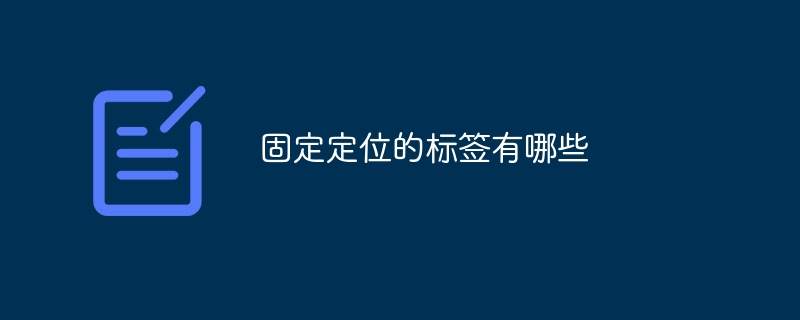
Fixed positioning tags include div, header, footer, nav, aside, figure, figcaption, etc. Detailed introduction: 1. div is a general block-level element, usually used to build page layouts. By setting its position attribute to fixed, the element can have a fixed positioning; 2. header, is a semantic block-level element. Usually used to represent the title or header information of the page, by setting its position attribute to fixed, etc.

The operating system for this tutorial: Windows 10 system, DELL G3 computer.
Fixed positioning (Fixed positioning) is a CSS positioning strategy in which the position of an element is fixed relative to the browser window. It always stays in the same position even if the page is scrolled. This kind of positioning is often used for elements that need to always be displayed on the page, such as navigation bars, menus, etc. The following are some tags that use fixed positioning:
1. div: div is a general block-level element usually used to build page layouts. You can give an element fixed positioning by setting its position property to fixed.
<div style="position: fixed; top: 0; right: 0;">
这是一个固定定位的 div 元素
</div>2. Header: header is a semantic block-level element, usually used to represent the title or header information of the page. You can give an element fixed positioning by setting its position property to fixed.
<header style="position: fixed; top: 0; width: 100%;">
这是一个固定定位的 header 元素
</header>3. Footer: Footer is a semantic block-level element, usually used to represent the bottom information of the page. You can give an element fixed positioning by setting its position property to fixed.
<footer style="position: fixed; bottom: 0; width: 100%;">
这是一个固定定位的 footer 元素
</footer>4. nav: nav is a semantic block-level element, usually used to represent the navigation menu of the page. You can give an element fixed positioning by setting its position property to fixed.
<nav style="position: fixed; top: 0; width: 100%;">
这是一个固定定位的 nav 元素
</nav>5. aside: aside is a semantic block-level element, usually used to represent the sidebar or sidebar information of the page. You can give an element fixed positioning by setting its position property to fixed.
<aside style="position: fixed; bottom: 0; width: 100%;">
这是一个固定定位的 aside 元素
</aside>6. Figure: Figure is a semantic block-level element, usually used to represent illustrations or pictures on the page. You can give an element fixed positioning by setting its position property to fixed.
<figure style="position: fixed; top: 0; right: 0;">
这是一个固定定位的 figure 元素
</figure>7. figcaption: figcaption is a semantic inline element, usually used to represent the title or description of a picture or illustration. You can give an element fixed positioning by setting its position property to fixed. Note, however, that since figcaption is an inline element, you may need to use other block-level elements (such as divs) to simulate its effect.
In addition to the tags mentioned above, you can also use other tags (such as span, p, etc.) in conjunction with the CSS position: fixed attribute to achieve fixed positioning. However, it is important to note that fixedly positioned elements are not affected by the regular document flow and therefore may result in increased page layout complexity. Therefore, the effects and layout implications need to be carefully considered when using fixed positioning.
The above is the detailed content of What are the fixed positioning tags?. For more information, please follow other related articles on the PHP Chinese website!




